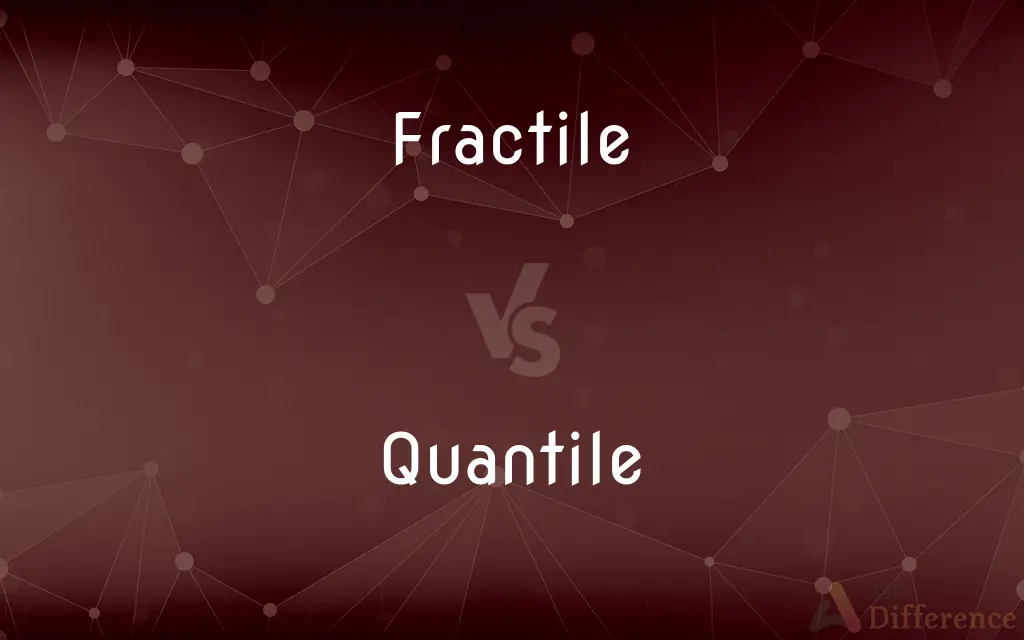Fractile vs. Quantile — What's the Difference?
By Tayyaba Rehman & Maham Liaqat — Updated on April 24, 2024
Fractiles are specific types of quantiles; fractiles divide a set into equal parts, while quantiles measure specific points in a data distribution.

Difference Between Fractile and Quantile
Table of Contents
ADVERTISEMENT
Key Differences
Fractiles are statistical measures used to divide a set of data into equal parts, often to help in understanding distribution patterns. Whereas quantiles, which include quartiles, deciles, and percentiles, are points that divide the distribution of a dataset into continuous intervals with equal probabilities.
Fractiles are useful for dividing data into groups with an equal number of observations, simplifying complex data sets into more manageable segments. On the other hand, quantiles are more flexible in application, allowing statisticians to identify and analyze specific positions within data, such as the median (50th percentile).
When dealing with fractiles, the emphasis is often on the proportion of the division, such as halves, quarters, or eighths of a dataset. Whereas quantiles focus on the values at specific points, which define the boundary of these intervals.
In practice, fractiles help in tasks like stratified sampling where uniformity in group sizes is desired. Quantiles, however, are frequently used in financial risk assessments, where identifying extremes (like the 95th percentile) is crucial.
Fractiles generally imply a more structured approach to data segmentation, aiming for uniformity in the size of each segment. In contrast, quantiles can vary widely in how they segment data, depending on the specific requirements of the statistical analysis or business needs.
ADVERTISEMENT
Comparison Chart
Definition
Divides data into equal parts
Divides data based on specified intervals
Common Types
Halves, quarters, eighths
Quartiles, deciles, percentiles
Primary Use
Simplifying data sets
Detailed data analysis
Focus
Uniformity in group sizes
Position within a distribution
Example Applications
Stratified sampling
Financial risk assessment
Compare with Definitions
Fractile
A statistical measure that divides data into equal parts.
Dividing a class into quartiles is an example of using fractiles.
Quantile
A flexible tool in statistical analysis for various data types.
Quantiles are essential in econometrics for modeling income distributions.
Fractile
A method used to create homogeneous subgroups within a dataset.
In market research, fractiles can help segment customers into equal groups.
Quantile
Represents specific positions or thresholds in data.
The lower quantile in customer satisfaction survey data helps identify areas needing improvement.
Fractile
A quantifiable boundary in data segmentation.
The first quartile is a fractile that represents the top 25% of data.
Quantile
A statistical measure used to describe the underlying distribution of data.
Quantiles help identify the spread and central tendency of data.
Fractile
A division point in a dataset where each part contains an equal number of data points.
The median is a fractile that divides data into two equal parts.
Quantile
A point or range in a dataset that divides the data into intervals of equal probability.
The 90th percentile is a quantile that separates the lowest 90% from the top 10%.
Fractile
A statistical tool for equal distribution analysis.
Fractiles are used to ensure each subgroup in a study has the same number of subjects.
Quantile
Often used in risk management to understand potential extremes.
Risk managers use quantiles to estimate worst-case scenarios.
Fractile
(statistics) The value of a distribution for which some fraction of the sample lies below.
The q-quantile is the same as the (1/q)-fractile.
The median is the .5-fractile.
Quantile
In statistics and probability, quantiles are cut points dividing the range of a probability distribution into continuous intervals with equal probabilities, or dividing the observations in a sample in the same way. There is one fewer quantile than the number of groups created.
Fractile
Describing the quality of a sedimentary stone as it relates to the sediments to cohesively bond without fracturing.
A stone with a low fractile strength lacks tensile strength and will crack or crumble under stress or pressure.
Quantile
Each of any set of values of a variate which divide a frequency distribution into equal groups, each containing the same fraction of the total population.
Quantile
(statistics) One of the class of values of a variate which divides the members of a batch or sample into equal-sized subgroups of adjacent values or a probability distribution into distributions of equal probability.
Common Curiosities
Is the median a quantile or a fractile?
The median is both a quantile and a fractile as it divides the data into two equal parts and represents the 50th percentile.
How do fractiles differ from quantiles?
Fractiles focus on dividing the data into segments of equal size, whereas quantiles divide data based on defined intervals that may not have equal numbers of observations.
What is a fractile in statistics?
A fractile is a statistical measure that divides a dataset into equal parts, each containing an equal number of observations.
Why are fractiles important in data analysis?
Fractiles are important as they help in creating uniform groups within a dataset, facilitating easier analysis and comparison.
How do fractiles simplify data interpretation?
Fractiles simplify data by ensuring each segment has an equal number of observations, making patterns more recognizable and comparable.
Can you give an example of a quantile?
Yes, the 25th percentile is a quantile that separates the lowest 25% of data from the rest.
What are quartiles and how do they relate to fractiles?
Quartiles are a type of quantile that divide data into four equal parts, each representing a key fractile in data distribution.
How do quantiles aid in financial analysis?
Quantiles, particularly in risk management, help in determining potential extreme values and assessing the probability of certain outcomes.
Are quantiles and percentiles the same?
Percentiles are a specific type of quantile, specifically dividing the dataset into 100 equal parts.
What role do quantiles play in statistical modeling?
Quantiles help model different parts of a data distribution, useful in predicting outcomes and understanding variability.
What makes fractiles unique in data segmentation?
Fractiles ensure equal numerical representation in each segment, unlike other methods that may not evenly distribute data.
What is the difference between deciles and percentiles?
Deciles divide data into 10 equal parts, while percentiles divide it into 100 equal parts, both serving as forms of quantiles.
How do quantiles impact decision making in business?
Quantiles provide critical insights into data distribution, helping businesses make informed decisions based on statistical probabilities.
How are fractiles used in market research?
In market research, fractiles can be used to segment consumers into equal groups based on characteristics like spending habits.
Can quantiles be used for all types of data?
Yes, quantiles are versatile and can be applied to any data type, aiding in a broad range of statistical analyses.
Share Your Discovery

Previous Comparison
Bodge vs. Botch
Next Comparison
Breadstick vs. BreadAuthor Spotlight
Written by
Tayyaba RehmanTayyaba Rehman is a distinguished writer, currently serving as a primary contributor to askdifference.com. As a researcher in semantics and etymology, Tayyaba's passion for the complexity of languages and their distinctions has found a perfect home on the platform. Tayyaba delves into the intricacies of language, distinguishing between commonly confused words and phrases, thereby providing clarity for readers worldwide.
Co-written by
Maham Liaqat















































